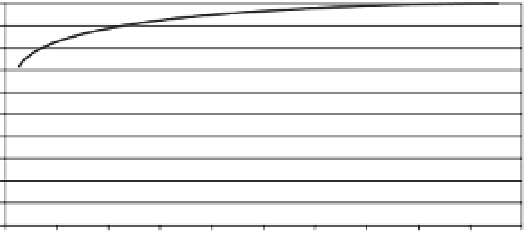Agriculture Reference
In-Depth Information
100
90
80
70
60
50
40
30
20
10
0
0
100
200
300 400 500
Density at emergence (p/m
2
)
600
700
800
900
1000
Fig. 5.6.
Relative fibre content as a function of the seeding rate expressed in plants/m
2
. A synthesis of
the trials undertaken by ITC (2003) (SPC, FNPC) and FNPC (1975, 1976, 1977, 2000, 2001, 2002) and
FDGEDA de l'Aube (1982, 1989).
500
450
400
350
300
250
200
150
100
50
0
2
5
10
20
30
35
45
50
54
60
65
70
75
80
90 100
Density of seeding (kg/ha)
Fig. 5.7.
Density at emergence (plants/m
2
) as a function of the seeding rate (kg/ha).
certain tests) and were highest for the high
seeding rate, as described above.
The height of the crop correlates weakly
with population density. High density produces
shorter plants, due to competition for water
and nitrogen. Where the seeding rate was less
than 50 kg/ha, the height of the crop at har-
vest declined with increasing density (with 20
cm difference between the shortest and tallest
plants). Where the seeding rate was higher
(>50 kg/ha), further increases in seeding rate
did not produce a reduction in plant height at
harvest. This result is not, however, reflected in
the height gained during canopy establishment
and the early stages of the growth cycle. During
this period, a low seeding rate resulted in the
fewest plants, due to competition for light.
In the early stages of growth, this elonga-
tion at high seeding rate resulted in thinner
stalks and a concomitant elevation of relative
fibre content at harvest, independent of any
losses.
Influence of seeding rate
on hurd yields
Hurd yields rose rapidly with increased seed-
ing rate when the latter was less than 20 kg/
ha. At this rate, hemp was not able to estab-
lish complete canopy and smother weeds.
At a seeding rate of 20 kg/ha, the hurd yield
was 90% of its potential (Fig. 5.8). At higher
densities, the yield continued to grow with
increasing density, but much more slowly, to
the point that the seeding rate became
immaterial. At a seeding rate of 35 kg/ha,
the hurd yield was 95% of its potential, and
97% at 50 kg/ha.

































































































